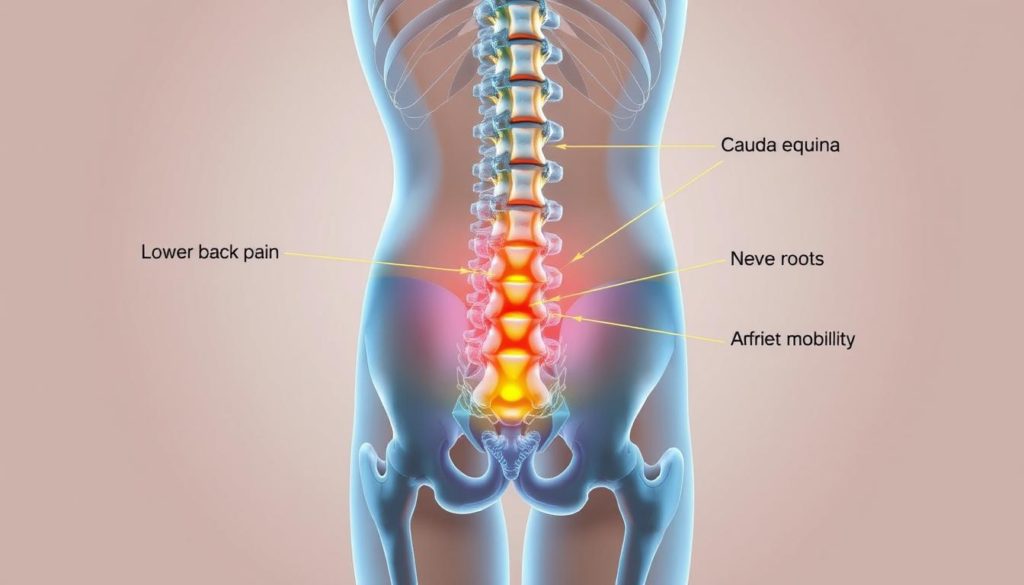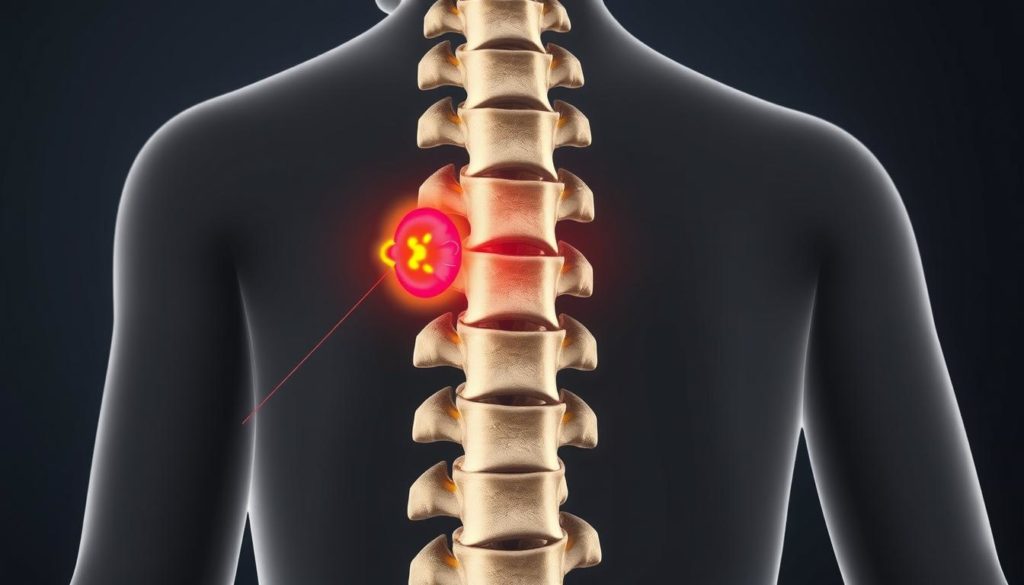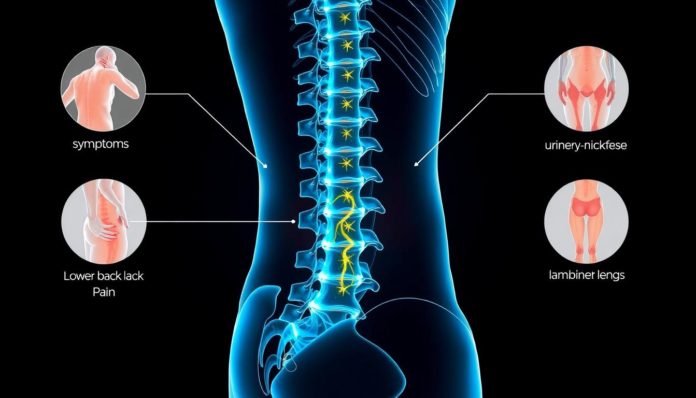Cauda Equina Syndrome (CES) is a serious medical condition that demands immediate attention. It happens when nerves at the spine’s base get squeezed. This can cause severe lower back pain, incontinence, and leg weakness. Recognizing CES symptoms early is key to avoid lasting harm and recover well.
What Is Cauda Equina Syndrome?
Cauda Equina Syndrome (CES) is a serious medical issue. It happens when the cauda equina nerve roots are compressed and not working right. This condition can lead to major problems and needs quick medical care to prevent lasting damage.
The Anatomy and Function of the Cauda Equina
The Cauda Equina Anatomy is unique. It has nerve roots that look like a horse’s tail. These nerve roots control the motor and sensory functions in the lower body and pelvic organs.
They help with movement, feeling, and automatic body functions. These are all crucial for day-to-day life.

Causes of Cauda Equina Syndrome
Several conditions can lead to problems with the cauda equina nerve roots. A big herniated disc in the lower back pressing on these nerves is the most common cause. Other reasons include:
- Spinal lesions or tumors
- Spinal infections and inflammations
- Spinal stenosis
- Traumatic injuries to the spine
- Complications from spinal surgeries or anesthesia
Knowing these causes shows why it’s crucial to quickly recognize and treat CES. This helps avoid serious, long-term problems.
Common Causes of Cauda Equina Syndrome
Cauda Equina Syndrome (CES) is serious and needs quick medical help. It can come from injuries, swelling, or growths in the spine.
Herniated Discs
Lumbar herniated discs are a top cause of CES. They happen when a disc in the lower back breaks or sticks out. This puts pressure on the nerves. It can come from an injury, lifting heavy objects, or aging. This leads to intense pain and problems moving. It’s important to get it checked quickly.
Spinal Infections and Inflammation
Infections and inflammation in the spine can also cause CES. These infections may start from bacteria, surgery, or other infections in the body. They put a lot of pressure on the nerves. This leads to pain, fever, and problems with nerve functions. Getting treatment fast is crucial.

Tumors and Spinal Lesions
Spinal tumors are another big reason for CES. Both non-cancerous and cancerous tumors can press on the nerves. This causes CES. Doctors use special scans to find these tumors. Then, they might suggest surgery or radiation to help the nerves.
Understanding Lower Back Pain Symptoms
Millions of people are affected by lower back pain. It signals various health issues, such as Cauda Equina Syndrome (CES). Spotting symptoms early is key to getting the right treatment and stopping worse problems.
Why Lower Back Pain Should Not Be Ignored
Disregarding lower back pain can have serious outcomes. Knowing the serious causes behind lower back pain helps spot CES early. Experiencing constant or intense pain, especially with symptoms like difficulty urinating or loss of feeling in the lower areas, means you should see a doctor quickly.
When to Seek Medical Attention for Back Pain
It’s crucial to know when back pain needs a doctor’s look. Never ignore ongoing or sharp pain, especially if it comes with signs of nerve trouble. Key CES red flags are loss of bladder control, weakness in the legs, and numbness in the groin area. Missing these signs could mean lasting nerve harm.
Finding the cause of your back pain early helps avoid permanent damage. It’s vital to understand the causes of lower back pain and know the signs of Cauda Equina Syndrome for your wellbeing.
Leg Weakness Symptoms in CES
Experiencing leg weakness can signal Cauda Equina Syndrome (CES). This symptom comes from nerve root damage in the cauda equina. It leads to severe neurological issues. Spotting CES leg weakness early is key. It majorly affects how one moves and lives day-to-day. Let’s explore how to recognize these symptoms and their effect on daily life.
Identifying Leg Weakness Symptoms
Leg weakness in CES varies from slight to total paralysis. This might make simple tasks like walking or standing hard. Recognizing these primary neurological symptoms Cauda Equina means looking for signs such as:
- Difficulty rising from a seated position
- Frequent stumbling or falls
- Decreased sensation or numbness in the legs
- Inability to lift the foot (foot drop)
The Impact on Mobility and Daily Life
As CES leg weakness worsens, moving around gets harder. In the worst cases, one may need a wheelchair or walking aids. This affects both body and mind. Doing simple tasks can feel overwhelming. Thus, early action and proper treatment plans are crucial.
| Symptoms | Mobility Impact | Daily Life Challenges |
|---|---|---|
| Leg Weakness | Reduced Walking Ability | Difficulty with Household Tasks |
| Foot Drop | Frequent Tripping | Dependence on Assistive Devices |
| Muscle Atrophy | Loss of Leg Strength | Impaired Personal Care |
Bladder Dysfunction Symptoms
Bladder dysfunction is a big worry for people with Cauda Equina Syndrome. It’s important to know the symptoms. This helps manage the condition and get treatment quickly. This can stop more problems from happening.
Signs of Urinary Retention and Incontinence
In Cauda Equina Syndrome, problems mostly show as urinary retention symptoms and incontinence. People might not feel when they need to pee. Or they can’t control their urine, causing leaks.
- Lack of urge to urinate despite a full bladder
- Involuntary leakage or dribbling of urine
- Frequent urinary tract infections due to residual urine
Managing Bladder Dysfunction
Handling incontinence management well is key for those with Cauda Equina Syndrome. Here are vital ways to manage this issue:
- Intermittent self-catheterization to relieve urinary retention
- Using absorbent pads or adult diapers for incontinence
- Maintaining a strict hygiene routine to prevent infections
Teaming up with healthcare experts is a smart move. They help create a care plan that fits the patient. This plan makes managing urinary retention symptoms and incontinence better. It improves life for those dealing with Cauda Equina Syndrome.
Sciatica Symptoms Associated with CES
Sciatica symptoms play a key role in spotting Cauda Equina Syndrome (CES). These issues stem from pressure on nerves in the lower back. This leads to major discomfort and could affect walking or mobility.
Pain in Lower Extremities
Pain spreading to the lower body is a common sign of CES. This pain can feel sharp or burning. It makes daily tasks hard and lowers life quality. Spotting these symptoms early can stop more serious problems.
Why Sciatica Should Be Taken Seriously
It’s critical not to overlook sciatica signs. When they appear with other warning signs of Cauda Equina, like trouble controlling the bladder or weak legs, getting medical help fast is key. Quick treatment can prevent lasting harm and help recovery.
Neurological Symptoms of Cauda Equina Syndrome
Understanding the seriousness of CES neurological symptoms is crucial. These symptoms show major pressure on the cauda equina. Immediate action is needed to stop permanent harm.
Saddle Anesthesia
Saddle anesthesia appears as numbness in parts that would touch a saddle. This includes the buttocks, genital area, and anus. It points to urgent nerve issues. Quick medical help is vital.
Sexual Dysfunction
CES can lead to serious sexual problems. It changes feeling and ability in this area. This can really hurt a person’s life. Feelings in the pelvic area might also lessen.
Severe Nerve Pain
Intense nerve pain is a scary sign of CES. This pain can be very strong and hurt everyday life. It’s important to find out what’s wrong fast. This helps ease the bad pain.
| Symptom | Description | Impact |
|---|---|---|
| Saddle Anesthesia | Numbness in the pelvic region, buttocks, and anus | Immediate medical attention required |
| Sexual Dysfunction | Loss of sexual sensation and function | Severe impact on quality of life |
| Severe Nerve Pain | Intense and debilitating nerve pain | Interference with daily activities |
Cauda Equina Syndrome Symptoms to Watch For
It’s crucial to spot Cauda Equina Syndrome (CES) symptoms early. Immediate signs to look for include:
- Sudden or severe back pain: This pain is often felt in the lower back and gets worse over time.
- Bladder and bowel difficulties: Trouble controlling bladder and bowel functions is a major warning sign.
- Sciatica: Lasting leg pain that suggests nerves may be getting squished.
- Saddle anesthesia: Losing feeling in parts of your body that touch a saddle, like your inner thighs, buttocks, and genitals.
- Sexual dysfunction: Sudden sexual function issues could mean CES.
- Leg weakness: Feeling weak or numb in your legs can greatly affect how you move and do everyday tasks.
Noticing these signs early on is key for diagnosing CES. Getting help right away is needed to avoid lasting harm. Quick action leads to better treatment and chances of recovery.
Cauda Equina Emergency Signs
Knowing Cauda Equina red flags is key to avoid lasting harm. This syndrome shows up with strong symptoms that need quick help. Acting fast is crucial to prevent permanent nerve damage.
The Importance of Immediate Medical Attention
As soon as Cauda Equina red flags symptoms appear, getting fast medical help is crucial. Symptoms can be sudden severe lower back pain, not feeling your legs, and trouble controlling bladder or bowels. It’s critical to act swiftly for Immediate CES treatment. This usually means surgery to ease the pressure on nerves.
Diagnostic Tests for CES
Finding out if it’s Cauda Equina Syndrome needs careful check-up and special scans. Important CES diagnostic testing includes MRI and CT scans. These show where the nerves are pinched. These scans guide doctors on how to proceed with Immediate CES treatment.
| Diagnostic Test | Purpose | Process |
|---|---|---|
| MRI | Identify nerve compression | Non-invasive imaging |
| CT Scan | Detailed look at bone structures | Cross-sectional images |
| Myelogram | Spinal cord and nerve roots | X-ray with contrast dye |
Diagnosing Cauda Equina Syndrome
Getting the right diagnosis for Cauda Equina Syndrome is crucial for effective treatment. Doctors look at the patient’s medical history and do physical check-ups, imaging tests, and lab tests. They are all important to find out what’s causing the problem and choose the best treatment.
Patient History and Physical Examination
First, doctors take a detailed history from the patient. They ask about symptoms like lower back pain, weakness in the legs, bladder issues, and any injury or infections recently. Then, they do a physical exam. They check for problems with nerves, changes in feeling, and how strong the muscles in the legs are. This step is key to spotting symptoms of CES and figuring out what to do next.
Imaging Studies
Imaging tests are key to confirming if someone has Cauda Equina Syndrome. An MRI is especially useful. It shows clear pictures of the spinal cord and nerves. This helps find if nerves are squeezed. CT scans are also useful. They show the bones and can find issues like herniated discs, tumors, or infections in the spine. These tests are critical for understanding what’s causing the symptoms.
Laboratory Tests
Lab tests also help in diagnosing this condition. Blood tests and other lab work help find infections, inflammation, or cancer that might be making the condition worse. Combining patient history, check-ups, imaging, and lab tests allows doctors to accurately diagnose Cauda Equina Syndrome. Then they can start the right treatment.
FAQ
What is Cauda Equina Syndrome (CES)?
Cauda Equina Syndrome (CES) is a serious health issue. It occurs when nerve roots at the spine’s base get squeezed. This can lead to severe back pain, weak legs, problems with bladder control, and more. It’s very important to get surgery quickly to stop lasting harm.
What are the main symptoms of CES?
CES’s main signs are intense lower back pain and issues with bladder control. You might also feel weak in the legs, have sciatica, lose feeling in certain areas, and have problems with sexual function. These signs mean the nerves are being squeezed and you need to see a doctor right away.
What causes Cauda Equina Syndrome?
Most of the time, a big herniated disc in the lower back causes CES. It can also come from spinal issues, tumors, infections, being injured, or after spine surgery. Understanding the cause is vital for treatment.
Why is lower back pain associated with CES significant?
Lower back pain matters because it can also mean you have other serious CES signs. These include not being able to pee, leg weakness, and losing feeling in certain areas. If your back really hurts and you have these problems, see a doctor immediately to avoid permanent injuries.
How does CES affect leg strength and mobility?
CES can make your legs weak or even paralyze them by squeezing nerve roots. This can greatly affect your ability to move and your daily life. It’s important to spot and treat leg weakness early to help with recovery.
How is bladder dysfunction related to CES?
A major sign of CES is having trouble with bladder control. This could mean not feeling like you need to pee or not being able to hold it in. These issues are complex and need careful management to avoid more problems, like infections.
Can CES cause sciatica?
Yes, CES can lead to sciatica. This brings on pain that moves down your back and legs. If you have sciatica with other CES signs, get checked right away to stop things from getting worse.
What are the critical neurological symptoms of CES?
Important CES signs to watch out for include not feeling anything in your lower body, severe nerve pain, and sexual issues. These mean the nerves are really being squeezed and you need urgent care.
What should I do if I notice symptoms of CES?
If you have severe back pain, trouble with the bathroom, sciatica, numb areas, or weak legs, get medical help immediately. Fast action is key to preventing lasting harm.
What diagnostic tests are used to identify CES?
Doctors use MRI and CT scans to look at the spinal cord and nerves, alongside tests for infections or tumors. These tests help make a good treatment plan.
What does the diagnosis process of CES entail?
Figuring out if someone has CES means getting a lot of information from them, doing a physical check, and looking inside with scans like MRI and CT. Sometimes, tests for other conditions are needed. Quick and correct diagnosis helps in treating properly.


